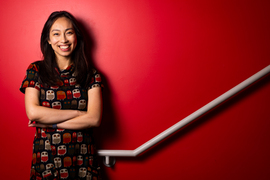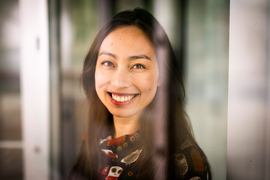As a high school student who loved math, Lisa Ho ’17 was drawn by MIT’s spirit of “mens et manus” (“mind and hand”) and the opportunities to study both a subject and its practical applications. Now a PhD candidate in economics, Ho also appreciates the lessons in perseverance gleaned from her time on her high school robotics team that have translated to her current studies.
“It was the first time I was heavily invested in a project where the challenge was open-ended with no correct answer, so you were never ‘done’ with the work,” says Ho. “Effort didn’t necessarily translate into external validation. But I think that helped me to develop some patience and appetite for ambiguous work that doesn’t always pay off quickly.”
Labor and gender
When she first arrived at MIT, Ho was looking for a way to apply her interest in math to tackling social issues, and she initially settled on computer science. But as a junior, she took a new class in the Department of Economics offered by professors Esther Duflo and Sara Ellison, 14.31 (Data Analysis for Social Scientists), which piqued her interest in an entirely new aspect of numbers.
“I had a sense that I wanted to apply statistics and coding to study social issues,” explains Ho. “What I didn’t anticipate was that taking the class would teach me about what economics could be. Before that class, I thought that economists studied a much narrower set of topics.”
One study that Ho remembers learning about in that class examined gender-related differences in whether candidates who lose elections continue their political careers. She was struck by how economic principles and data analysis could be used to address a huge variety of questions about society.
For her dissertation, Ho is studying the intersection of gender and labor-force participation in India, where there’s a particularly large gap between men and women. So far, Ho’s research has found that most available jobs are not compatible with the expectations of domestic responsibilities that many women face.
Given that finding, “Two strategies come to mind,” explains Ho. “You can either try to change people’s attitudes around gendered divisions of labor at home so that women can take the jobs that are available, or you could try to change the jobs to be better-suited to people’s attitudes.”
Ho focuses on the latter strategy, noting that attitudes and behavior mutually inform each other, and so short-term, part-time jobs that shift attitudes might serve as a stepping stone to more intensive labor market involvement. She spent much of 2021-2022 in West Bengal running a randomized controlled trial with over 1,500 households. With the help of her co-authors Anahita Karandikar and Suhani Jalota, along with a 25-person field team, Ho offered her study participants a set of jobs with different flexible arrangements, varying these attributes experimentally to test which ones made the job most appealing to women who would otherwise be outside the labor force.
Some factors investigated included the ability to multitask between work and childcare, flexibility to choose work hours, and the ability to work from home. To estimate the causal effect of women’s employment, jobs were offered to a randomly selected subset of survey participants. Then, Ho and her team evaluated whether having job experience influenced attitudes and made households more open to women’s work. They also studied how workplace flexibility impacted job performance. Coordinating the logistics for a large-scale study was difficult at times, she says, but connecting with the study participants made it all worth it.
“I love doing research and having my research be related to what’s on people’s minds day-to-day,” says Ho. “One of the most enjoyable parts of the project on women’s employment for me was accompanying my field team while they conducted surveys. Many of the questions we ask stir up passionate discussion, like the question about whether men should do an equal share of the housework.”
Part of Ho’s interest in this area is personal. Growing up, her grandmother told her how her mother, who lived in the Bronx, had wanted to work but wasn’t allowed to.
“My great-grandfather wouldn’t allow it because he was worried about what other people would think,” says Ho, who was born in Singapore and spent most of her school years in the U.K. “He said that if his wife worked, other people would think he couldn’t support his family. Even looking within my own family, I can see there’s been a lot of progress in the last century, but there’s still a ton of work to be done with respect to women all over the world.”
Ultimately, Ho’s family and upbringing — one of her parents is Singaporean and the other is American — helped her to develop a broad perspective that she now utilizes when trying to answer her research questions. In addition to her global experiences as a child and an undergraduate, Ho spent a year as a Schwarzman Scholar at Tsinghua University in China before returning to MIT for graduate school.
“I’ve had a lot of exposure to different cultures and points of view, and that helps me in my research in terms of feeling at home among any group of people,” she says. “And it means I’m already used to a wide range of views on these topics, which keeps me open-minded when I listen to our study participants.”
A passion for teaching
Throughout her time at MIT, Ho has nurtured a passion for teaching and mentorship. As an undergraduate, she worked with the Educational Studies Program to organize outreach activities for middle and high school students. And she has enjoyed her experience as a teaching assistant during her graduate program.
“Part of why I feel like TA’ing MIT undergrads is so rewarding is because I used to be them and now I’m on the other side,” she says. “They’re still trying to figure out what they’re interested in and what they want to do, which makes it feel very impactful to introduce them to new topics and to show them — just like I was shown as an undergrad! — that economics is a much broader field than most college students think when they graduate from high school.”
As she approaches the completion of her degree, Ho, too, is giving thought to what comes next. She wants to have the freedom to pursue the questions that move her the most. For now, she is making the most of her time at MIT and the opportunity to learn from the professors who inspired her to pursue economics in the first place. “I want to be an economist whose work is grounded in challenges that come up in people’s everyday lives — especially women’s and children’s,” she says. “To contribute to pragmatic policy solutions to those problems, being trained by professors in the MIT Development Economics group, such as Esther Duflo, Ben Olken, Frank Schilbach, David Atkin, and Abhijit Banerjee — it’s the ideal graduate school experience.”












